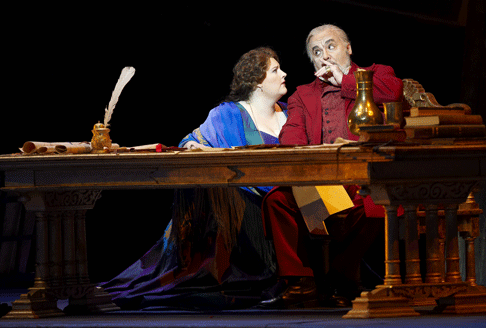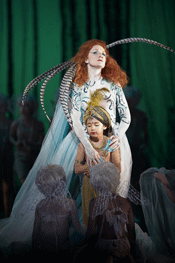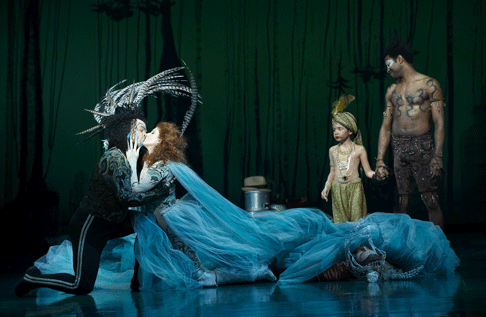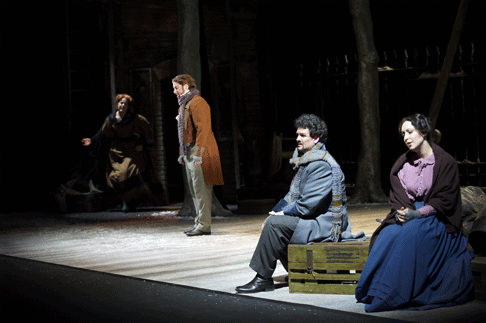12 May 2009
Canadian Opera on the rise
How often does one experience an opera in which everything works — in which there is not one flaw either in the staging or in its musical dimensions?

How often does one experience an opera in which everything works — in which there is not one flaw either in the staging or in its musical dimensions?
Toronto’s Canadian Opera Company overwhelmed its audience with just such perfection in the production of Verdi’s Simon Boccanegra that opened the company’s spring season in the still-new Four Seasons Centre for the Performing Arts.
The staging, new at London’s Covent Garden a year ago, was directed by Ian Judge, who in addition to his credentials as one of today’s top international directors of opera, looks back on a quarter century with England’s Royal Shakespeare Company. Although the libretto for Boccanegra is largely by Francesco Maria Piave, Judge brought the insights of a major Shakespearean to Verdi’s 1881 revision of the work, first staged in Venice in 1857.
Judge has a strong sense of dramatic flow of “Boccanegra” and thus eschewed the divisions into acts and the in-between-curtains that traditionally interrupt it. With a single intermission after the curse that ends the Council scene, this was a staging, seen on May 3, that kept the audience almost breathlessly engaged throughout its three hours.
In the title role Italy’s leading Verdian Paolo Gavanelli headed a cast without a weak link. Especially for those who saw Dmitri Hvorostovsky in this role in San Francisco last fall, Gavanelli brought a new depth to the role.
Minus the Russian’s Hollywood handsomeness, Gavanelli’s Boccanegra was good generation older than the man played by Hvorstovsky. The result was a man of greater seriousness and experience, indeed a man Lear-like in his dignity and suffering. Vocally Gavanelli set the standard for the rest of the cast. Tamara Wilson, a young American soprano from Houston’s studio program, played Maria as a woman both intelligent and vulnerable and handled high notes with power or delicacy — as the moment demanded.
Canada’s Phillip Ens was impressive as Fiesco, and Russian Mikhail Agafonov was his equal as Adorno. Marco Guidarini, respected as a Verdi conductor throughout Europe, displayed a fine sense for both music and drama in his work with the COC’s excellent orchestra. And the chorus, rehearsed by Sandra Horst, was fully caught up in the drama.
Sets by John Gunter were traditional with touches of modernity in sloping walls and a titled pillar. Lavishly rich costumes were by Deirdre Clancy. Nigel Levings was responsible for unusually effective lighting.
Judge brought Shakespearean majesty to the death of Boccanegra, an aspect clearly in the mind as he indicated in a program note on the opera: “It has all the qualities of a Shakespeare play. Verdi loved Shakespeare. He wrote [here] a Shakespeare drama in his own way, and that’s what is terrific.” This was indeed and in every way a terrific Boccanegra!
 Tamara Wilson as Maria Boccanegra and Paolo Gavanelli as Simon Boccanegra
Tamara Wilson as Maria Boccanegra and Paolo Gavanelli as Simon Boccanegra
All in all, this production, although planned when the late Richard Bradshaw was still COC CEO, speaks highly of the commitment to continuing excellence by new general director Alexander Neef and recently appointed music director Johannes Debus. (Bradshaw had filled both offices.)
Second triumph of the COC spring season was Benjamin Britten’s Midsummer Nights Dream in a co-production with Houston Grand Opera, seen on its opening night May 5. For the staging of the 1960 work designer Dale Ferguson — responsible for both sets and costumes — created a dreamscape that drew the capacity audience into the world of enchantment that Britten made of Shakespeare’s drama.
Animation was brought to the diaphanous set in spring-like shades of green by an immense “sleep sheet” that spanned the stage and descended on Britten’s characters when they truly slept. Ferguson’s richly imaginative land — upside-down trees decorated the set — provided an ideal environment for the ethereal singing that distinguished the production.
 Laura Claycomb as Tytania
Laura Claycomb as Tytania
As Tytania and Oberon, rulers of the fairy world, Laura Claycomb and
Lawrence Zazzo led the large cast that was superb in both serious and comic
moments. Texan Claycomb, of course, is a leading figure on the international
opera scene, and with her often buoyant chiffon train was a major force in
making this production a transcendent experience.
And Zazzo, confined for the most part to a gondola swinging above the stage, sang with a voice of unusual resonance that places him a step above the many countertenors on stage today. Mezzo Kelley O’Connor, famous for her performances of Peter Lieberson and Oswaldo Golijov, was a beautiful Hippolyta, perfectly partnered by Robert Gleadow as Theseus.
Adam Luther (Lysander), Elizabeth DeShong (Hermia), Wolfgang Holzmair (Demetrius) and Giselle Allen (Helena) — excellent all — completed the company of confused lovers. The rustic troupe responsible for the play-within-the-play in Dream was delightfully led by Thomas Goerz, while Robert Pomakov was a touching Bottom. As Flute, the role written for Peter Pears, Lawrence Wiliford recalled that Britten wrote his bel canto aria as a send-up of Joan Sutherland, whom he had recently heard as Lucia.
 (l - r) Lawrence Zazzo as Oberon, Laura Claycomb as Tytania, Robert Pomakov (lying on ground) as Bottom and Jamaal Grant as Puck
(l - r) Lawrence Zazzo as Oberon, Laura Claycomb as Tytania, Robert Pomakov (lying on ground) as Bottom and Jamaal Grant as Puck
Jamaal Grant played Puck — a speaking role — with the joy of the prankster that the character is. Of special distinction was the contribution made to the staging by the well-trained children’s choir.
Director Neil Armfield and conductor Anne Manson worked together to underscore the need for a proper balance of foolishness and gravity in the opera — and in life.
Damien Cooper’s sensitive lighting added to the magic of this exemplary production.
Given the admirable quality of these two productions, it is difficult to understand that the COC could allow itself the embarrassing mediocrity of the Bohème that completed the company’s spring season.
The revival of the company’s traditional 2005 staging — sets and costumes by, respectively, Wolgang Skalicki and Amrei Skalicki — was cast largely with alumni of the COC Ensemble Studio now singing with Canada’s regional companies.
 Anna Leese as Musetta, Peter Barrett as Marcello, David Pomeroy as Rodolfo and Frédérique Vézina as Mimì
Anna Leese as Musetta, Peter Barrett as Marcello, David Pomeroy as Rodolfo and Frédérique Vézina as Mimì
David Pomeroy (Rodolfo), Peter Barrett (Marcello), Peter McGillivray (Schaunard) and Frédérique Vézina (Mimì) all failed to make emotional contact with the roles they sang.
Better qualified for her assignment as Musetta was New Zealand’s Anna Leese, yet she too was painfully over- directed by Maer Gronsdal Powell, heretofore assistant to numerous directors of COC productions.
On her own here, Powell was at a loss for meaningful ideas that might have brought a dramatic impact to the staging that ran its course with no sense of direction. And COC Derek Bate, on the podium on May 4, chose for the final act a dirge-like tempo that left one wondering whether Mimi was going to live forever after all.
Hard as it is to imagine a Bohème that leaves an audience dry eyed, that was the unhappy case here.
The Canadian Opera Company now ranks sixth among opera companies in North America. Statistics provided by Opera America list the six first in terms of budget: the Met, $252 million, San Francisco Opera, $70 million, Chicago Lyric Opera, $54.3 million, Los Angeles Opera, $51 million, and New York City Opera, $42 million. And in number of performances, the COC with 68 slated for the up-coming season, is third after the Met with 225 and Chicago with 72.
In the past two seasons — this is the third in Toronto’s Four Seasons Centre — the COC has played to 99% of capacity houses, which is the record in North America. In Chicago it has been 93%; at the Met, 90%. In the same period the COC’s annual subscription rate has been 75%, again a North American record. In Chicago the average is 68%; at the Met, 32%.
The COC is clearly a company on the rise!
Wes Blomster